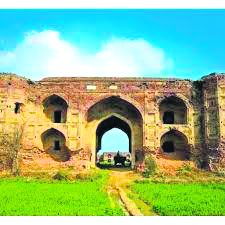
Nestled in the historic city of Ludhiana, Punjab, the Doraha Sarai Fort stands not only as a testament to the region’s rich cultural and architectural heritage but also as a star on the cinematic stage, thanks to its prominent role in the critically acclaimed Bollywood film “Rang De Basanti.” Let’s embark on a journey to explore the charm, historical significance, and celluloid allure of the Doraha Sarai Fort.
Historical Roots:
Doraha Sarai Fort, also known as Doraha Fort, traces its origins back to the 17th century during the Mughal era. Commissioned by Nawab Saadat Khan, the then-governor of Lahore, the fort was strategically situated along the Grand Trunk Road, a vital trade route connecting Delhi and Lahore. Its historical significance lies not only in its architectural grandeur but also in its role as a caravanserai—a resting place for travelers and traders traversing the bustling trade route.
Architectural Splendor:
The fort exhibits a distinctive blend of Mughal and Rajasthani architectural styles, characterized by intricately designed facades, arched gateways, and imposing walls. The structure includes a stunning baoli (stepwell), showcasing the architectural prowess of the bygone era. The grandeur of the fort captures the imagination of visitors, transporting them to a time when it served as a beacon of hospitality and trade.
Cinematic Brilliance in “Rang De Basanti”:
The cinematic brilliance of Doraha Sarai Fort came to the forefront when it was prominently featured in the 2006 Bollywood film “Rang De Basanti,” directed by Rakeysh Omprakash Mehra. The fort served as a key location in the movie, providing a visually striking backdrop for pivotal scenes that unfolded within its historic walls. The juxtaposition of the fort’s timeless beauty and the contemporary narrative of the film created a cinematic tapestry that resonated with audiences.
In “Rang De Basanti,” the fort becomes more than a physical setting; it transforms into a character, mirroring the emotions and turmoil experienced by the film’s protagonists. The fort’s grandeur stands in stark contrast to the challenges faced by the characters, emphasizing the interplay between history and the pressing issues of the present. This seamless integration of historical architecture and modern storytelling contributed to the film’s critical and commercial success.
Historical Narratives Unfold:
The fort, with its weathered walls and ornate architecture, became a canvas for the narratives that unfolded in “Rang De Basanti.” The echoes of the past resonated with the characters as they grappled with contemporary issues, blurring the lines between history and the present. The fort, in its silent magnificence, became a silent witness to the fictional revolution that unfolded within its precincts.
Conclusion:
Doraha Sarai Fort in Ludhiana, Punjab, emerges as a dual treasure—imbued with historical significance and immortalized on the silver screen through “Rang De Basanti.” Its architectural splendor and cinematic allure make it a must-visit destination for those intrigued by the intersection of history and film. As visitors wander through its ancient halls and gaze upon its timeless architecture, they embark on a journey that transcends time, connecting the past, the present, and the cinematic magic that has woven the fort into the cultural fabric of Ludhiana.